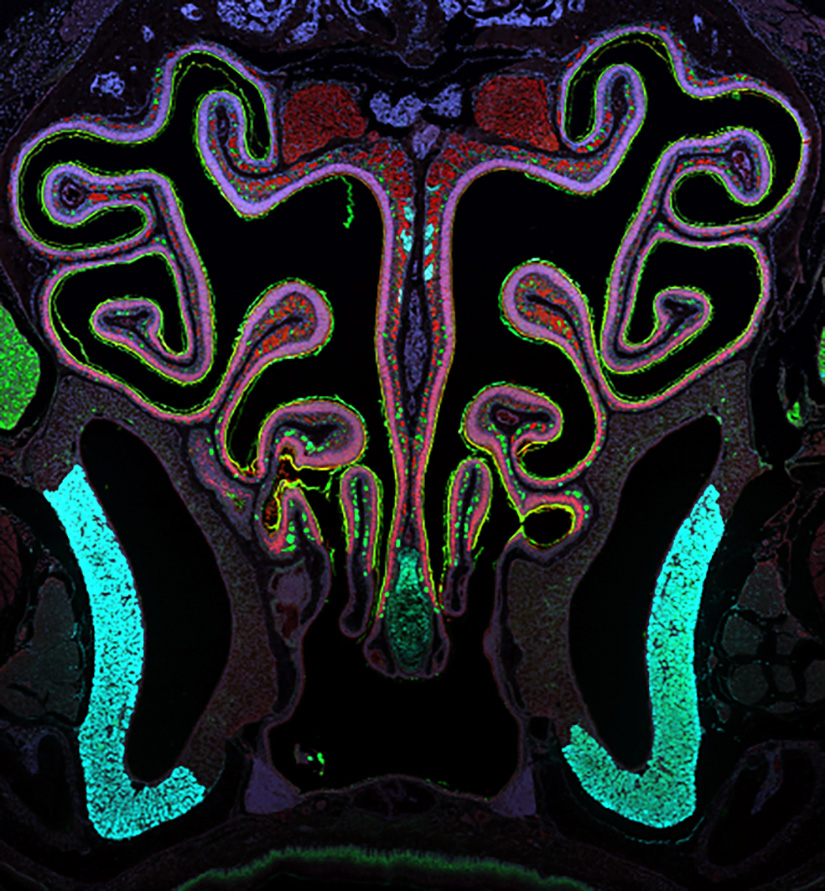Mapping Mucus in a Mouse
Enzymes that modify mucus proteins in the respiratory tract may protect against COVID-19 and other infections
Research Quick Pics
This rainbow-colored image isn’t from a psychedelic black light poster like the ones sold in a counterculture mall store. It’s actually a microscopic view of the mucus-coated sinuses and nasal passages of a mouse. The mouse’s olfactory tissue (red), responsible for sensing smell, contains proteins called mucins, which are major components of mucus. Mucins are decorated with chains of sugars that give them their shape and consequently give mucus its thick and sticky texture. The mucus keeps these airways moist and provides a barrier against irritating debris and infections. In the image, one specific kind of sugar chain (green) covers the mucins in the olfactory tissue, while another kind of sugar chain (teal) shrouds the mucins lining the sinuses.
Senior Investigator and NIDCR Associate Director Kelly Ten Hagen, Ph.D., studies how and why these sugar chains are added to proteins like mucins, and how certain diseases arise when they aren’t added correctly. During the pandemic, she and her team, including former Staff Scientist E Tian, Ph.D., partnered with Darryl Zeldin, M.D., and his lab at the National Institute of Environmental Health Sciences (NIEHS) to study SARS-CoV-2, the virus that causes COVID-19. Together they found that some of the enzymes that add sugar chains to mucins can also add these same chains to the spike protein on the virus. The spike protein typically enables the virus to get into cells, but the team’s experiments suggested that addition of these sugar chains may ultimately prevent the virus from entering and infecting cells. The findings were published in the Proceedings of the National Academy of Sciences.
As an extension of that work, Dr. Ten Hagen’s team and their NIEHS collaborators recently mapped the locations within the mouse respiratory tract of 20 sugar-chain-adding enzymes, 18 mucin proteins, and two kinds of sugar chains, which are depicted in teal and green in the image above. The team published this follow-up study in Glycobiology.
"This study provides foundational knowledge about which mucins and their modifying enzymes comprise the mucus in the respiratory system and how their expression is altered collectively upon infection and injury,” said Dr. Ten Hagen. “These findings may provide valuable insights into how the body protects itself against infectious diseases such as COVID-19."
Related Links
- Legacies of the Pandemic
- NIH Scientists Discover Norovirus and Other “Stomach Viruses” Can Spread Through Saliva
- Taste Nerve Reveals Coronavirus Entryways
- Scientists Identify Mechanism That May Influence Infectivity of SARS-CoV-2 Variants
- Scientists Find Evidence that Novel Coronavirus Infects the Mouth’s Cells
References
- Zhang L, Mann M, Syed ZA, Reynolds HM, Tian E, Samara NL, et al. Furin cleavage of the SARS-CoV-2 spike is modulated by O-glycosylation. Proc Natl Acad Sci U S A. 2021 Nov 23;118(47):e2109905118. doi: 10.1073/pnas.2109905118.
- Tian E, Syed ZA, Edin ML, Zeldin DC, Ten Hagen KG. Dynamic expression of mucins and the genes controlling mucin-type O-glycosylation within the mouse respiratory system. Glycobiology. 2023 Jun 21;33(6):476-489. doi: 10.1093/glycob/cwad031.
Attention Editors
Reprint this article in your own publication or post to your website. NIDCR News articles are not copyrighted. Please acknowledge NIH's National Institute of Dental and Craniofacial Research as the source.
Subscribe for NIDCR Updates
Receive email updates about the latest advances in dental, oral, and craniofacial research.
June 2024

